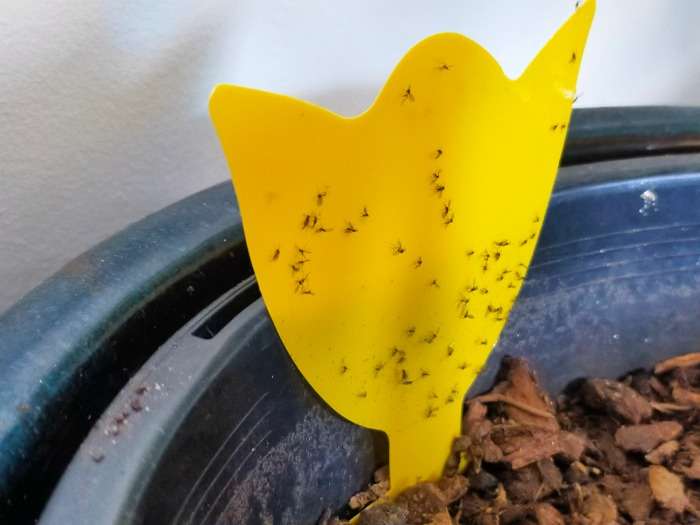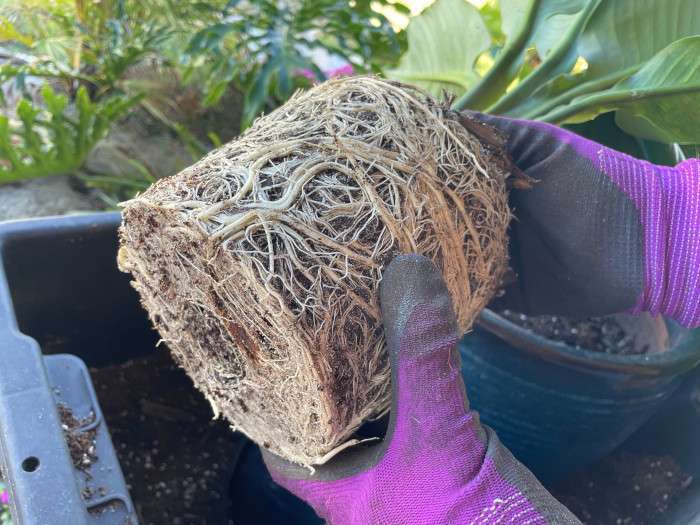Why is my fern dying? If you’ve ever found yourself frustrated after a lot of attempts to keep your ferns healthy, welcome to the club. Ferns are famously finicky plants, but the truth is, their needs vary widely depending on the type. Some ferns are incredibly low-maintenance plants, while others need more attention to thrive.
As someone who’s grown a lot of different types of ferns over the years, I’ve learned a lot about what makes them tick—and what causes them to wilt.
In this guide, I’ll walk you through the common issues ferns face and share my tips on how to troubleshoot and turn things around. With a little knowledge and the right conditions, you’ll be able to work out what’s going wrong and get your ferns back to a lush, healthy plant.
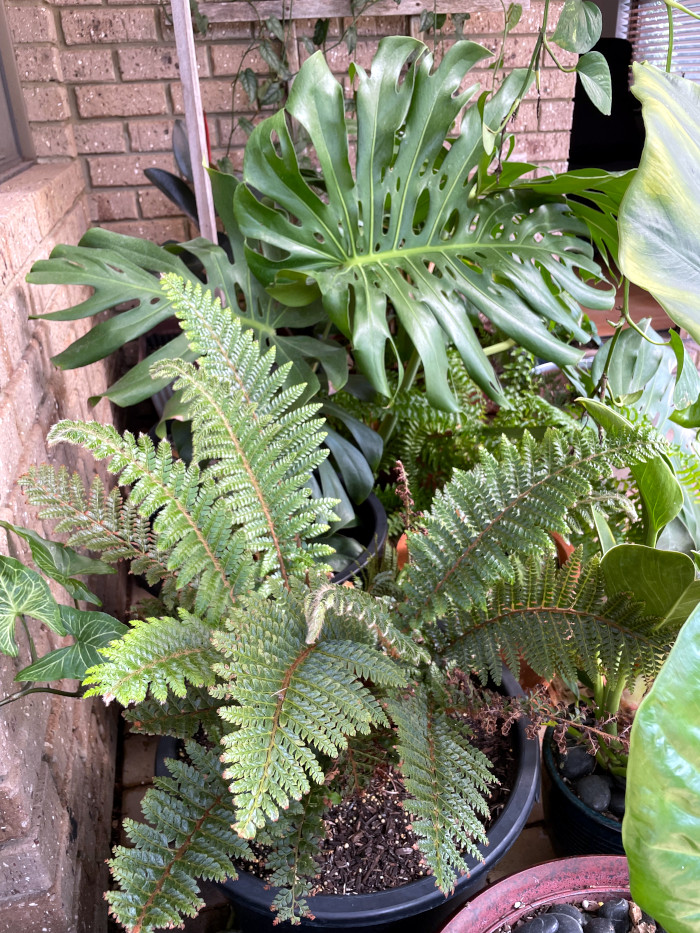
Causes of Fern Leaves Turning Brown or Yellow
A common symptom of a dying fern are those shrivelled, brown or yellow fronds. Often the fronds will go yellow first before eventually turning brown. Both are signs of plants in distress and often they have similar causes and solutions.
When dealing with fern problems, it’s important to take a holistic approach. If your fern is struggling, it’s rarely just one thing causing the issue, so it’s worth looking at what conditions its growing in and figuring out what could be improved.
1. Overwatering Ferns
Overwatering is one of the most common reasons for fern leaves turning brown or yellow. It’s the most likely problem so pay a lot of attention to this area. Here are some signs that your fern might be drowning:
- Brown, yellow, squishy, or soft leaves: These can point to excess moisture in the plant’s tissues, often due to overwatering or root rot.
- Damp soil: If the soil stays damp for too long, it can stress the plant or lead to root rot.
- Growing in a dark location: Less light means your fern needs less moisture. Overwatering in these conditions can cause problems.
- Presence of fungus gnats: Fungus gnats thrive in moist soil and often show up when there’s too much water, signalling a potential overwatering issue.

How to Prevent Overwatering Ferns
Use a Proper Watering Routine
During summer, you can water your fern about once a week. In winter, water every two weeks. Always check the soil before watering—stick your finger about an inch deep. If it feels moist or soil sticks to your finger, wait a few days before watering again.
Choose a Well-Draining Potting Mix
Ensure your potting mix suits your fern’s needs. Ferns like to stay consistently moist—not too dry, not too wet—and require good drainage and aeration. I use a homemade potting mix that works well for me.
Give Fern the Right Amount of Light
While ferns do well in low light, too little light can make them more prone to overwatering. To help your fern recover, try moving it to a slightly brighter spot. More light will encourage growth and help the plant absorb more water. If it’s in a very dark location, reduce watering so it dries out more.
How I Handled Overwatering in My Fern

One of my ferns has been struggling lately. It’s placed at the back of the room, far from any windows, so it’s been pretty dark. As you can see, the soil is still quite moist, and there’s a lot of browning and dying leaves that are squishy to the touch. All of this points to overwatering—too much water for too long in this pot.
The potting mix I use is one I always rely on, so I was pretty sure it wasn’t the mix causing the issue. I decided to move the fern into a much brighter spot near a window to give it more light. This should help it recover by encouraging growth, which will help it absorb more water.
I also completely stopped watering until the soil dried out. Once it was dry, I went ahead and trimmed off all the dying brown foliage to give it a fresh start.
2. Underwatering Ferns
Since ferns like constant moisture its possible they may be underwater, here’s what to look out for:
- Bright location: Ferns in very bright locations may require more frequent watering, as the increased light speeds up moisture loss.
- Slow loss of vibrant colour: Unlike many plants, ferns won’t necessarily wilt but will gradually lose their vibrant green colour.
- Brown tips on fronds: The tips of the fronds will start to turn brown, and the brown spots may expand along the fronds.
- Crispy fronds: If the fronds feel crispy and crunchy when touched, this is a key sign of underwatering.
- Dry soil: If the soil is dry to the touch, it could indicate the fern isn’t getting enough water.

How to Fix Underwatering in Ferns
Use a Moisture Retentive Potting Mix
Use a good potting mix that retains moisture while still being well-draining and aerated. This balance will help prevent both underwatering and overwatering issues. Ferns like a little bit more moisture and organic matter compared to other indoor plants so make sure your mix reflects that.
Consider Ferns Lighting
If your fern is in a brighter spot, it will grow more, needing more frequent watering. However, a moisture-retentive potting mix will reduce how often you need to water. I usually check the soil before adding water, aiming to water every week or two.
Mulch for Moisture Retention
Consider adding a layer of mulch, like peat moss, to the top of the soil. This helps absorb moisture and prevents evaporation, ensuring your fern stays moist longer.
3. Chlorinated Tap Water
Many ferns, including hardy ones like the Australian sword fern, are sensitive to chlorinated water from taps. The issue can be hard to identify because the symptoms develop gradually. Things to look out for include:
- Browning Leaves: Water with chlorine can cause gradual browning, especially at the tips.
- Slow Growth: Ferns may stop growing or grow much slower when exposed to chlorinated water.
- General Stress: Leaves may start to lose their vibrancy, becoming dull or discoloured.
Chlorinated Tap Water Solutions
Use Filtered Water
Filtered water is the closest thing to rainwater, which is great for plants. It won’t contain harsh chemicals, like chlorine, that plants are sensitive to.
Dechlorinate the Water
A popular solution is using a product like Stress Coat, often used in aquariums, to remove chlorine from the water. I just add a drop to my 8L watering can, give it a stir, and you can start watering within a minute.
You can also leave your watering can out overnight to let the chlorine dissipate into the air, but this won’t work with chloramine. Make sure to check what your local water supply uses.
4. Too Much Light for the Fern
Ferns naturally grow under the canopy in forests, so they prefer dappled light. While some species can handle brighter conditions, most ferns don’t tolerate direct sunlight well. Signs that your fern is getting too much light include:
- Crispy, dry fronds: As the fern dries out from lack of moisture, the leaves become crunchy because of insufficient moisture at the roots.
- Dry soil: More light often means faster soil drying, though the foliage usually shows signs first.
- Sun damage vs. underwatering: Sun-damaged leaves show scorch marks on fronds, while underwatering causes dry, crispy leaves. Both issues may occur in very bright locations.
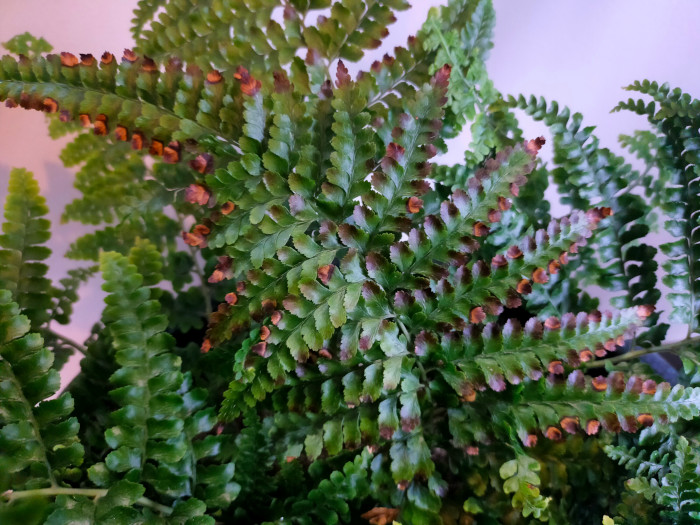
How to Reduce the Light Intensity
Move Fern Away from Window
A window usually dilutes the light enough to prevent browning, but if you live in a very warm, sunny climate or if the window receives a lot of direct sunlight during the day, it might be better to move the fern to the side of the window or further away, about 1 meter (3 feet).
Filter the Light
You can use blinds or curtains to soften the direct sunlight. Another option is to use taller plants that can tolerate more light to act as a buffer and natural canopy, providing shade and protection from sunburn while still allowing your fern to receive the light it needs to thrive.
5. Fern Pests
I don’t tend to get many pests on my ferns but when I do it’s almost always scale insects. When your fern is looking a bit under the weather its easy to give it a quick check for the following things:
- Spider mites: Look for tiny webs on your fern, often in dry, dusty areas.
- Scale insects: Small white or fuzzy spots on the fronds.
- Sticky or oily leaves: A sign of pest activity, especially from scale insects.
- Discoloured leaves: Yellowing or browning of leaves caused by nutrient loss from pests.
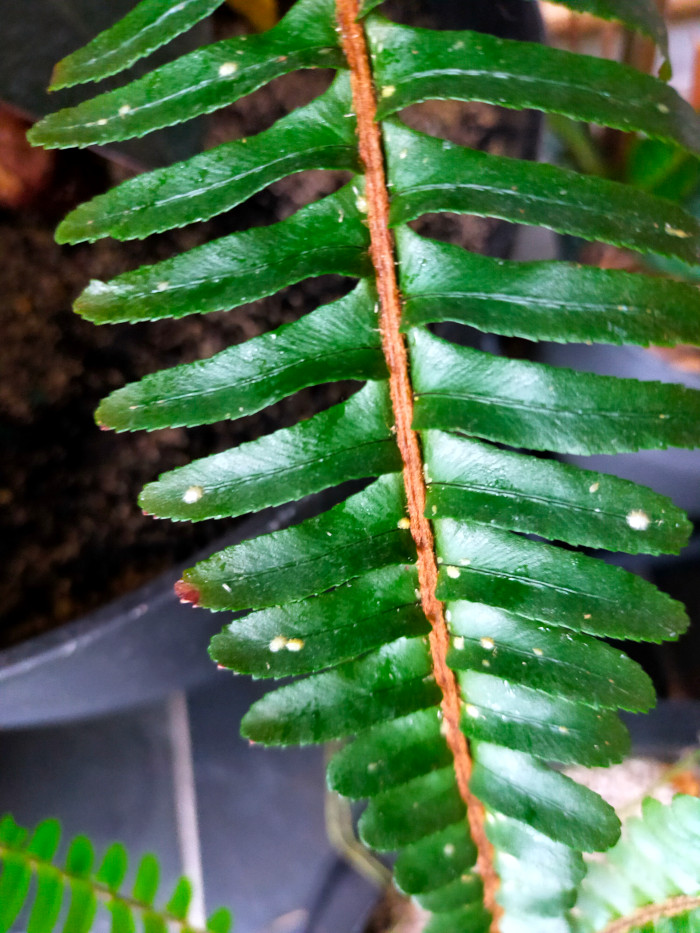

How to Deal with Fern Pests
Use Insecticidal Sprays
To treat pests, the solution is usually the same: apply horticultural oil (also known as white oil) or neem oil if you prefer something more natural. Mix the solution according to the manufacturer’s instructions. It’s best to take the fern outside and spray it thoroughly, making sure to cover the undersides of the leaves and the stems, where pests tend to hide.
After a few days, you should see the scales turning brown, indicating that they are dead. At this point, you can trim off the damaged fronds, or if the damage isn’t too severe, you can leave them on the plant.
If you notice pests on one plant, its a good idea to check your other plants as I find scale and other pests can quickly spread.
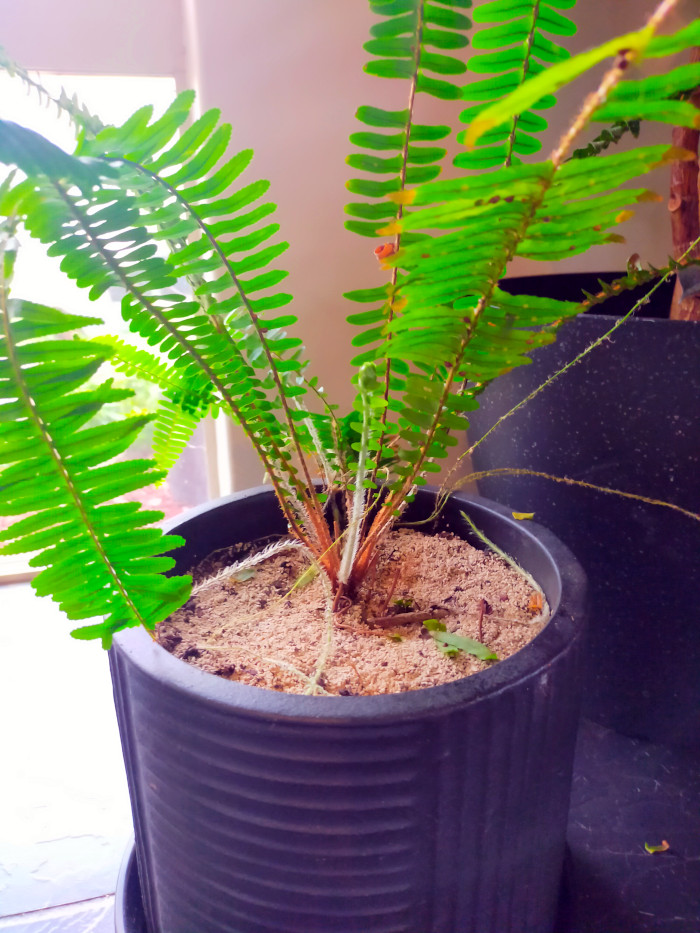
6. Fern Diseases
I find ferns pretty resilient to diseases in general but you may sometimes get them. Some common diseases include:
- Leaf Spot Diseases: Fungi create brown or black spots on fronds.
- Rusts: Fungi cause brown or orange bumps on fronds.
- Powdery Mildew: Fungal coating turns fronds white, then brown.
- Bacterial Leaf Spot: Bacteria cause brown or black spots with yellow edges.
- Bacterial Blight: Bacteria create brown, wet spots on fronds.

How to Fix Ferns with Diseases
Improve Air Flow
Most fungus and other diseases thrive in moist, humid conditions. Improving airflow and circulation around your fern can help disrupt these environments and prevent issues from developing.
This could be as simple as giving your plants a little extra space between them and not overcrowding.
Remove Contaminated Foliage
When watering, inspect the fronds for signs of disease. If you spot any, remove the affected ones to prevent the spread. This can help stop the disease if it’s caught early and hasn’t spread too far.
Consider Fungicides and Chemicals
If necessary, use fungicides or other chemicals, carefully following the instructions on the packaging. Copper fungicides are a common and effective choice for dealing with fungal issues.
7. Fern Nutrient Deficiency
If your potting soil is old or you have pets, your plants may also be suffering from a nutrient deficiency. Symptoms to look out for include:
- Yellowing leaves: Older leaves may yellow while new leaves remain green, as the plant prioritizes nutrients for new growth.
- Slow or stunted growth: Lack of essential nutrients can lead to slower development.
- Nitrogen deficiency: Yellowing of older leaves as nitrogen is redirected to newer growth.
- Potassium deficiency: Browning at the edges of the leaves.
- Magnesium deficiency: Yellowing between leaf veins.

How to Fix a Fern With Nutrient Deficiency
Repot Your Fern
To fix nutrient deficiencies, I like to tackle them all at once because if a plant is deficient in one nutrient, it’s probably lacking in others as well. Repotting your fern in fresh potting mix can restore those essential nutrients. It’s a simple way to give your plant a fresh start and ensure it’s getting what it needs.
Regular Fertilizing
You should fertilize every other week during the growing season, which occurs in the warmer months. Choose a balanced fertilizer or one specifically designed for your plant type to provide the right mix of nutrients. I like to use liquid fertilizer cause its easier to mix it in when you are doing your watering.
Remember, over-fertilizing can also harm your plant, so follow the instructions on the fertilizer package carefully.
8. Fern Humidity
People say low humidity can cause brown leaves, it’s hard for me to verify because I live in a very dry climate with no humidity at all most of the year. In my experience this is often much less important if not at all compared to the other conditions for your plant.
Plants are quite adaptable and ferns are no exception and they can thrive in areas with no humidity.
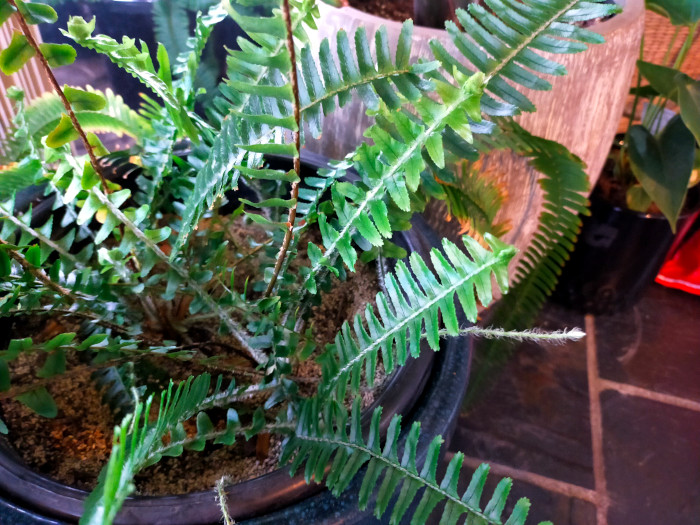
How to Add Humidity
I don’t find it necessary, but in their natural habitats, ferns would often experience more humid environments, and it’s possible this could help your ferns thrive. If you’d like to increase humidity, here are a few ways to do so:
Use Humidifier
There are a few different types of humidifiers. Most models have a vent that directs the moisture into a specific area, so it’s important to place the humidifier away from walls to prevent mould growth. Ideally, you should have one in each room where you keep plants to ensure optimal humidity.
Alternatively, there are ambient humidifiers that release moisture more gradually into the air, without the need to be placed directly with your plants. These can be effective for increasing overall humidity in a room, even if they’re not placed right next to the plants.
You can also place your ferns in naturally more humid spaces, such as the kitchen or bathroom, where humidity levels tend to be higher.
Group Your Plants
Grouping your plants together can increase the humidity in the area, as each plant traps moisture beneath its leaves, creating a micro environment similar to a forest but on a smaller scale. Additionally, grouping plants creates a lush, cohesive look that will enhance the appearance of your indoor garden.
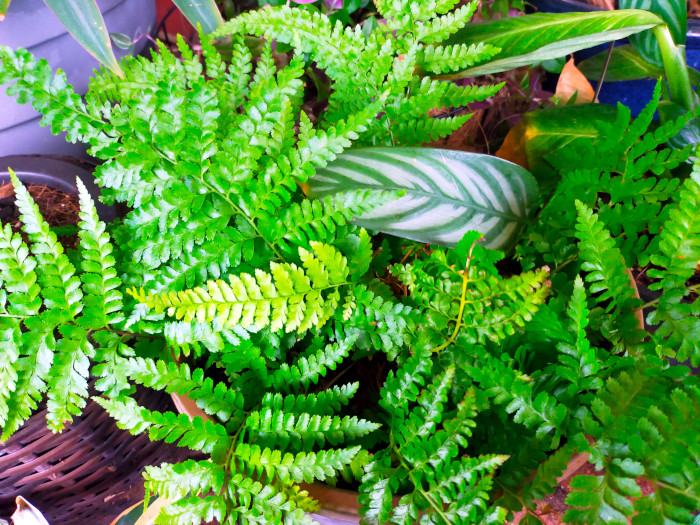
Pebble Trays
A popular suggestion for increasing humidity is to use trays filled with pebbles and water. As the water evaporates, it releases moisture into the air, which can help increase humidity around your plants. While this method may provide some benefit, its impact is probably minimal, and it can be quite labour-intensive, especially if you have multiple plants, as the trays will need to be refilled regularly.
For a more effective and convenient solution, consider using a humidifier, grouping your plants together, or combining both methods for a more consistent humidity boost.
9. Fern’s Age
Plants generally drop old foliage as they get older to make way for new, healthier growth which can produce energy better for them.
- Yellowing or Browning of Older Fronds: If an older, mature frond starts to yellow, brown, or lose all its foliage, this could be a natural process.
- Compare With Healthy Fronds: Check other, younger fronds on the plant. If they’re still healthy and vibrant, the yellowing or browning is likely due to the aging process of the older frond.
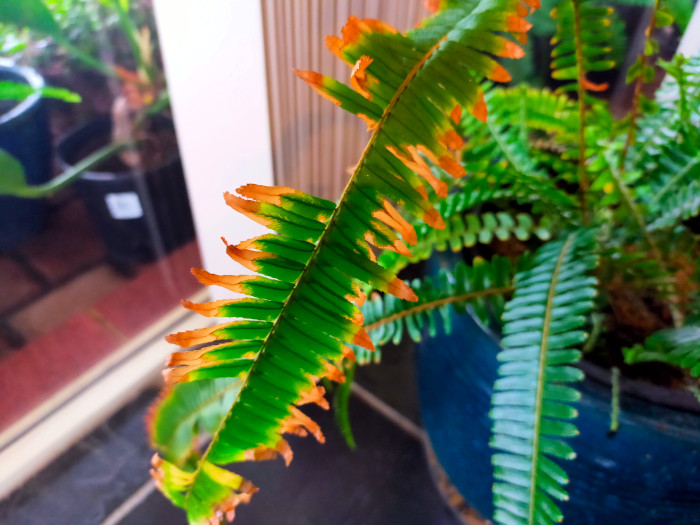
You can go ahead and cut any brown or dead fronds off, I do it all the time. The plant will grow new fronds back even if it has no fronds left at all.
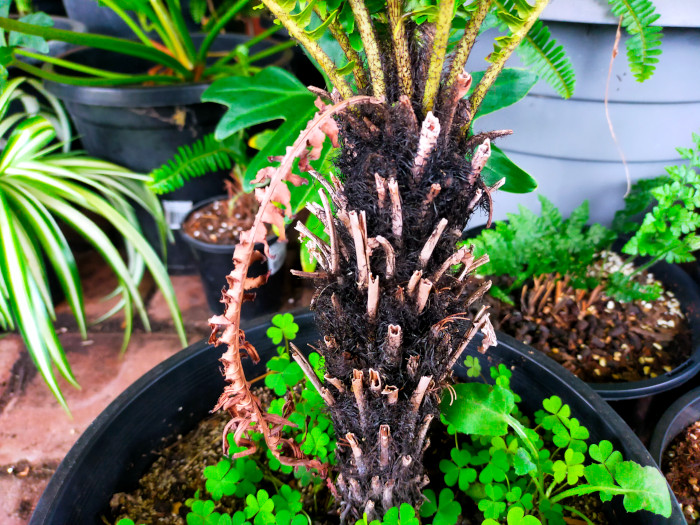
FAQ
Should I Cut Off Brown Fern Leaves?
Yes, go for it. The plant will struggle to maintain the brown areas, so removing them not only makes your fern look better but also helps improve its overall health.
Will Ferns Come Back?
Yes ferns despite being very finicky can also be very hardy. In my experience even if a fern looks dead with no foliage on it, it’s possible it will regrow new fronds and recover.
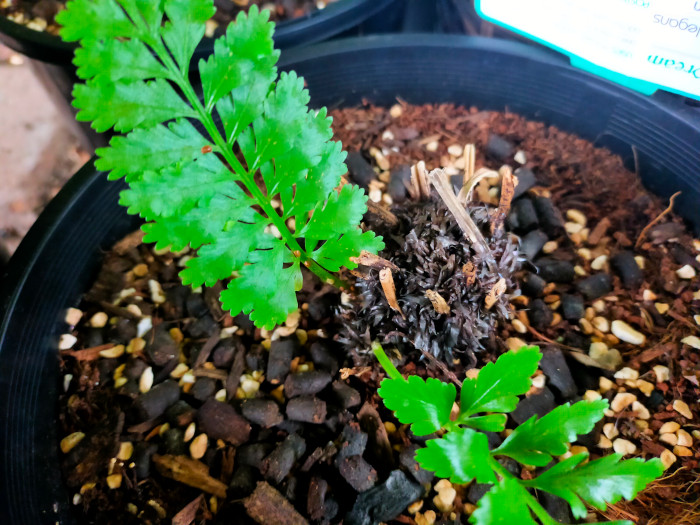
How Can I Make My Fern More Bushy?
To get a bushier fern, make sure it’s getting plenty of bright, indirect light and keep the soil consistently moist (but not soggy). Rotate the plant every time you water it to help it grow evenly, and give it a boost with fertilizer during the growing season. Snipping off any dead or damaged fronds can also encourage fuller growth.
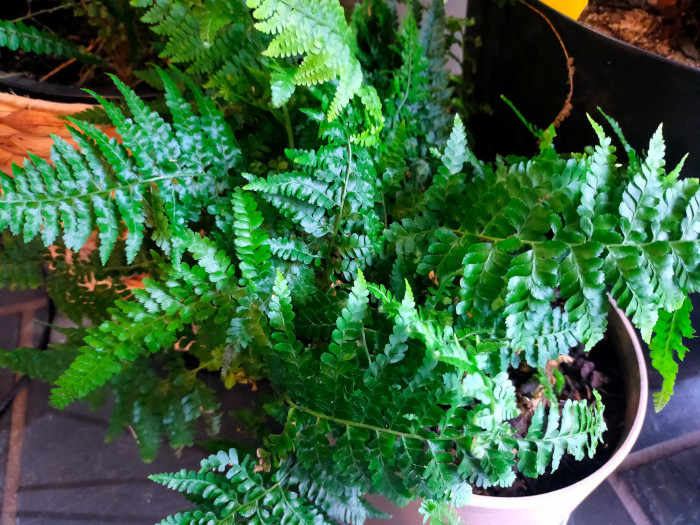
What Are the Brown Spots on the Underside of Fern Leaves?
These spots are called sori, and they’re how ferns release their spores. Unlike other plants, ferns use spores instead of seeds to reproduce. Don’t worry—these spots aren’t a disease or anything harmful to your plant.
Conclusion
Maintaining nice looking ferns can sometimes be a bit of a pain, but with the right knowledge and attention to their specific needs, these plants can thrive. Understanding the causes behind issues like brown or yellow leaves and addressing them through proper watering, lighting and using a good potting mix will help you maintain healthy, vibrant ferns.

The key is to give them the right conditions, monitor and make adjustments as needed. With time, you’ll find that ferns are not only pretty hardy but also quite easy to grow. They make a great addition to any space and can help tie a display together.
